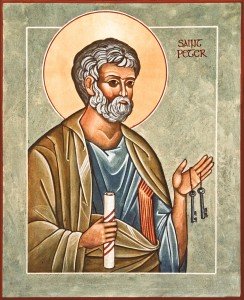There is a strong scholarly consensus that 2 Peter is the last New Testament (NT) document to be written. Some date it as late as 150 CE, and most date it between 120 and 150 CE. Among the reasons for dating it this late are its reference to 1 Peter, its mention of the letters of Paul, and its use of phrases from the letter of Jude. In addition, it offers an explanation for the delay of the second coming of Jesus (3:3-10). It should be remembered that most of the early disciples and apostles, including Paul, believed that Jesus would return in their lifetime.
As in 1 Peter, the author identifies himself as “Peter, a servant and apostle of Jesus Christ”. He refers to Peter’s impending death. He refers to himself as an eyewitness to the transfiguration of Jesus. As narrated in Marks (9:2-8) and in Matthew and Luke, only Peter, James and John were witnesses. But the letter is much too late to have been written by Peter or the author of 1 Peter.
We know nothing about the location of the author or the letter’s recipients. There are no geographical clues at all. The letter is not addressed to a specific Christ-community or even a region of communities. Thus it is classified as one of the “general” or “catholic” (meaning universal) letters.
The final chapter of the letter explains why the second coming of Jesus had not yet happened. The author refers to “scoffers” who will ask, “Where is the promise of his coming?” Already their ancestors had died (again suggesting a late date for the letter), but still the world continued as it was.
The author of the letter offers a twofold explanation for the delay. First, God’s time is not like our sense of time: “With the Lord one day is like a thousand years, and a thousand years are like one day”. Second, because of God’s patience, God is providing more time for “all to come to repentance.”
The more general theme of the letter is separation from the ways of the world and warnings about false prophets who seek to lure the recipients back into the ways of the world. The corruption of the world includes lust, deception, injustice, slander, adultery and greed. The words “lust” and “adultery” may refer to sexual desire and behavior, but often in the Bible they are metaphors for greed and idolatry. Those who entice them into the ways of the world are described as “bold and willful”, “irrational animals” who are “creatures of instinct”, “waterless springs and mists,” who speak “bombastic nonsense” and promise “freedom” even as they “are slaves of corruption.”
The antidote – the way of escaping the “corruption that is in the world” – is the power and promises of God, who has given them “everything needed for life and godliness” through Jesus.
Thus, like the NT as a whole, its last letter emphasizes love as the climatic Christian virtue. It is a very short letter and a worthwhile read. Why not take some time and read it.

